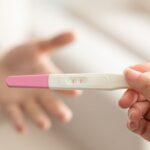For many women, distinguishing between premenstrual symptoms and early pregnancy indicators can be a confusing and stressful process. One of the primary symptoms that often causes uncertainty is vaginal discharge. Both premenstrual changes and early pregnancy can affect the nature and amount of discharge, but each has its distinguishing characteristics. This article will explore the common symptoms, causes, and diagnosis techniques related to discharge before a period versus discharge as an early pregnancy sign.
1. Understanding Vaginal Discharge and Its Role in the Reproductive Cycle
Vaginal discharge is a natural part of every woman’s reproductive health, serving as an important indicator of the body’s cyclical changes. Throughout a woman’s menstrual cycle, the consistency, colour, and amount of discharge may fluctuate, signalling various hormonal shifts. Discharge is typically influenced by estrogen and progesterone, the main hormones regulating the menstrual cycle.
In the luteal phase (the period following ovulation), many women experience a thicker, white, or creamy discharge due to elevated progesterone levels. This type of discharge is often referred to as leukorrhea and is normal. On the other hand, early pregnancy can also bring about changes in discharge, which may feel similar but serve a different purpose. Recognizing these subtle differences can provide valuable insight into one’s reproductive health.
2. Common Characteristics of Discharge Before a Period
Premenstrual discharge can vary depending on factors such as age, overall health, and hormonal fluctuations. Below are some typical features of discharge experienced before a period:
- Texture and Consistency: Often creamy, thick, or white; some may describe it as “milky.”
- Amount: Usually modest in quantity but may increase slightly as the period approaches.
- Colour: Commonly white or off-white; it may become somewhat yellow as it dries.
- Odour: Should be mild or odourless if the discharge is healthy.
These changes are generally a response to the natural rise in progesterone and decrease in estrogen, preparing the uterine lining for potential pregnancy. This type of discharge typically lasts a few days before the start of menstruation and may not be accompanied by other symptoms beyond minor discomfort.
2. Recognizing Early Pregnancy Symptoms: How Discharge Differs
In early pregnancy, discharge can become more prominent due to increased estrogen levels, which stimulate blood flow to the pelvic area and prompt the body to produce cervical mucus. Some early pregnancy discharge characteristics include:
- Consistency: Often more copious, with a wet or slippery texture that resembles egg whites.
- Amount: May increase compared to normal premenstrual levels.
- Colour: Can range from clear to milky white; should be mostly free of blood unless implantation bleeding occurs.
- Odour: Mild or odourless; changes in odour can indicate infection and warrant medical consultation.
In addition to changes in discharge, early pregnancy is often accompanied by other signs, such as nausea, breast tenderness, and fatigue. However, it’s important to note that discharge alone is not a definitive indicator of pregnancy, and other diagnostic steps are recommended.
4. Diagnosis Techniques: Understanding Your Body’s Signals
For those who suspect early pregnancy, several methods are available to help determine whether the observed discharge is a premenstrual symptom or an early pregnancy sign.
4.1 Observational Tracking
Tracking changes in discharge and other symptoms over a few cycles can help you recognize your body’s typical patterns. Noting the consistency, colour, and amount of discharge throughout the month can reveal valuable information.
4.2 Basal Body Temperature (BBT) Monitoring
Recording basal body temperature daily can provide clues about ovulation and potential early pregnancy. A sustained rise in BBT after ovulation may indicate pregnancy, though this method is not foolproof and is best used alongside other techniques.
4.3 Home Pregnancy Tests
Home pregnancy tests are a common option to confirm pregnancy if you miss your period. These tests detect the hormone hCG (human chorionic gonadotropin), which rises in early pregnancy. Brands like Clearblue offer a range of accurate and easy-to-use tests, including early detection options that can provide results a few days before a missed period.
4.4 Professional Medical Consultation
If confusion continues or unexpected symptoms show up, it’s always a good idea to check with a healthcare professional. They might suggest a blood test to get a clearer measurement of hCG levels or offer more advice based on your symptoms.
5. Exploring Causes Behind These Symptoms: What Triggers Changes in Discharge?
Both premenstrual changes and early pregnancy affect vaginal discharge in distinct ways due to hormonal shifts:
- Premenstrual Hormones: The post-ovulation phase, dominated by progesterone, creates a thicker, more substantial discharge as the body prepares for menstruation. As menstruation approaches, this discharge may become thicker and less prominent.
- Pregnancy Hormones: If fertilization occurs, estrogen levels rise to support the embryo, and cervical mucus production increases to maintain a safe environment. This hormonal surge leads to increased and more noticeable discharge, which serves as an early indicator for many.
Beyond hormonal causes, lifestyle factors like stress, diet, and overall health can influence discharge. Monitoring these symptoms, especially in combination with other early pregnancy signs or PMS, can clarify whether a change is normal or indicates a potential health concern.
6. Common Concerns and When to Seek Medical Advice
For some, abnormal changes in discharge can indicate infection or other reproductive health issues. If the discharge has a strong smell, turns green or grey, or comes with itching or discomfort, it’s best to see a healthcare provider.
Additional warning signs to watch for include:
- Persistent, unusual odour: A fishy or foul smell may indicate bacterial vaginosis or a yeast infection.
- Changes in colour: Greenish or yellow discharge could point to an infection.
- Pain or itching: Especially if localized around the vulva or vagina, these symptoms could signify an imbalance or infection that needs treatment.
7. Brands Promoting Reproductive Health Awareness
For many women, distinguishing between premenstrual symptoms and early pregnancy signs can be challenging, particularly when it comes to interpreting changes in vaginal discharge. While these bodily signals can provide clues about where you are in your cycle or the early stages of pregnancy, they’re often subtle and can easily be mistaken for one another. Trusted brands like Clearblue provide helpful solutions to make this process clearer and more manageable for anyone navigating these early, often uncertain stages.
Clearblue is a well-known name in reproductive health and diagnostics, offering products designed to deliver fast, reliable insights into pregnancy and ovulation.
By understanding the distinctions between premenstrual symptoms and early pregnancy signs, you’re taking a proactive step toward understanding your reproductive health. To gain deeper insight into the available solutions, read our next article on effective products that address











